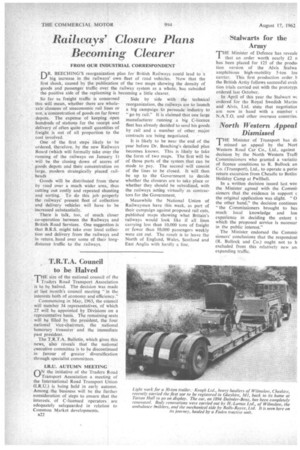Railways' Closure Plans Becoming Clearer
Page 28

If you've noticed an error in this article please click here to report it so we can fix it.
FROM OUR INDUSTRIAL CORRESPONDENT
nR. BEECHING'S reorganization plan for British Railways could lead to a big increase in the railways' own fleet of road vehicles. Now that the first shock, caused by the publication of the two maps showing the density of goods and passenger traffic over the railway system as a whole, has subsided the positive side of the replanning is becoming a little clearer.
So far as freight traffic is concerned this will mean, whether there are wholesale closures of uneconomic rail lines or not, a concentration of goods on far fewer depots. The expense of keeping open hundreds of stations for the receipt and delivery of often quite small quantities of freight is out of all proportion to the cost involved.
One of the first steps likely to be ordered, therefore, by the new Railways Board (which will formally take over the running of the railways on January 1) will be the closing down of scores of goods depots and their concentration on large, modern strategically placed railheads Goods will be distributed from these by road over a much wider area, thus cutting out costly and repeated shunting and sorting. To do this job properly the railways' present fleet of collection and delivery vehicles will have to be increased substantially.
There is talk, too, of much closer co-operation between the Railways and British Road Services. One suggestion is that B.R.S. might take over local collection and delivery from the railways and in return_ hand over some of their longdistance traffic to the railways. Side by side with the technical reorganization, the railways are to launch a big campaign to persuade industry to "go by rail." It is claimed that one large manufacturer running a big C-licence fleet has already decided to send his goods by rail and a number of other major contracts are being negotiated.
It is likely to be near the end of the year before Dr. Beeching's detailed plan becomes known. This is likely to take the form of two maps. The first will be of those parts of the system that can be made to pay. The second will consist of the lines to be closed. It will then be up to the Government to decide whether the closures are to take place or whether they should he subsidized, with the railways acting virtually as contractors for the Government.
Meanwhile the National Union of Railwaymen have this week, as part of their campaign against proposed rail cuts, published maps showing what Britain's railways would look like if all lines carrying less than 10,000 tons of freight or fewer than 10,000 passengers weekly were cut out. The result is to leave the North of England, Wales, Scotland and East Anglia with hardly a line.












































































































